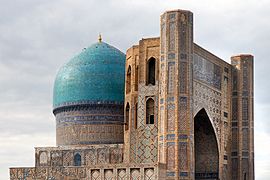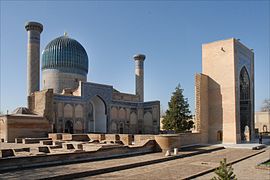Samarkand - the intersection of cultures
| Samarkand - the intersection of cultures | |
|---|---|
|
UNESCO world heritage |
|

|
|
| The Registan in Samarkand |
|
| National territory: |
|
| Type: | Culture |
| Criteria : | (i) (ii) (iv) |
| Reference No .: | 603 |
| UNESCO region : | Asia and Pacific |
| History of enrollment | |
| Enrollment: | 2001 (session 25) |
Samarkand - Crossroads of Cultures is one of the UNESCO -listed site of World Heritage in Uzbekistan . The world heritage site includes the historic city center ( Schahrestan ) of the city of Samarqand .
background
Afrasiab , the forerunner of Samarqand, was founded around 750 BC. Founded in BC and was the capital of the historical Sogdia region . Due to the trade with the northern and eastern regions and its location on the Silk Road , the city was conquered and destroyed by the troops of Genghis Khan in 1220 . No building has survived from the time before the Mongol invasion, but excavations have uncovered parts of old buildings.
It was not until the 14th century that the city was rebuilt under the name of Samarqand, but not at the old location, but about 1 km southwest of the old settlement hill . The Mongol ruler Timur made Samarqand the capital of his empire in 1369.
registration
Samarkand - Intersection of Cultures was registered in 2001 as the fourth World Heritage Site in Uzbekistan on the basis of a resolution of the 25th session of the World Heritage Committee.
The World Heritage Site covers an area of 1123 hectares and is surrounded by a 1369 hectare buffer zone. The actual protection area is composed of five separate zones: the archaeological excavation site Afrasiab (229 ha), the medieval and early modern urban area (841.5 ha), Ulug Beg's observatory (19.5 ha), the ensembles Abdi-Darun and Ishrat- Khona (26.3 ha) and the Namazgoh Mosque (6.7 ha).
The reason for the entry states, among other things:
“The historic city of Samarqand is the intersection and melting pot of the world's cultures. ... The historical part of Samarqand consists of three main sections. To the northeast is the ancient city of Afrosiab. … To the south are architectural ensembles and the medieval city of the Timurid era of the 14th and 15th centuries, which played an important role in the development of urban planning, architecture and art in the region. ... In the west is the area that corresponds to the extensions of the 19th and 20th centuries, which were built by the Russians in the European style. "
The entry was made on the basis of criteria (i), (ii) and (iv).
“(I): The architecture and the cityscape of Samarqand, located at the intersection of ancient cultures, are masterpieces of Islamic cultural creativity.
(ii): Ensembles in Samarqand such as the Bibi Chanum Mosque and Registan Square played an important role in the development of Islamic architecture throughout the region from the Mediterranean to the Indian subcontinent.
(iv): The historical city of Samarqand illustrates in its art, architecture and urban structure the most important stages of Central Asian cultural and political history from the 13th century to today. "
Even if individual buildings were not decisive for registration as a World Heritage Site, but rather the overall importance of the city as the intersection of ancient cultures, some individual buildings and building ensembles are particularly emphasized in the summary of the decision to register.
These include, above all, the Registan with its madrasas , the Ulugbek Madrasa , the Sher-Dor Madrasa and the Tilya-Kori Madrasa , as well as the complex of Bibi-Chanum-Mosque and Bibi-Chanum-Mausoleum . Also mentioned are the Shohizinda necropolis , the Gur-Emir ensemble and the Rukhabad ensemble, as well as the remains of Ulug Beg's observatory .
Web links
- Samarkand - Intersection of Cultures on the UNESCO World Heritage Center website ( English and French ).
Individual evidence
- ↑ Official names English Samarkand - Crossroad of Cultures , French Samarkand - carrefour de cultures , German translation according to the World Heritage List. In: www.unesco.de. German UNESCO Commission, accessed on July 6, 2018 .
- ↑ a b c d Samarkand - Crossroad of Cultures. In: whc.unesco.org. UNESCO World Heritage Center, accessed December 2, 2016 .
- ↑ Decision - 25 COM XA In: whc.unesco.org. UNESCO World Heritage Center, accessed November 29, 2016 .
- ↑ Samarkand - Crossroad of Cultures. Maps. In: whc.unesco.org. UNESCO World Heritage Center, accessed December 2, 2016 .
Coordinates: 39 ° 39 ′ 9 ″ N , 66 ° 58 ′ 12 ″ E





